Comparative Analysis: Accounting Regulation in Australia and Singapore
VerifiedAdded on 2020/05/28
|12
|3019
|27
Report
AI Summary
This report provides an executive summary comparing the accounting regulatory environments of Australia and Singapore. It begins with an introduction highlighting the importance of a strong regulatory environment in financial reporting and the role of regulatory bodies. Part A presents a literature review of the regulatory environments in both countries, discussing key issues such as inconsistencies in reporting requirements in Australia and the adoption of Singapore Financial Reporting Standards (SFRS). Part B explores the regulatory capture theory, explaining how regulatory agencies can be influenced by the industries they oversee. The report then analyzes the Australian and Singaporean environments through the lens of this theory, concluding that Australia's environment may be more susceptible to regulatory capture due to its focus on complying with IFRS, while Singapore's environment appears to prioritize public interest more. The report concludes by summarizing the key differences and implications of the regulatory environments in both countries.
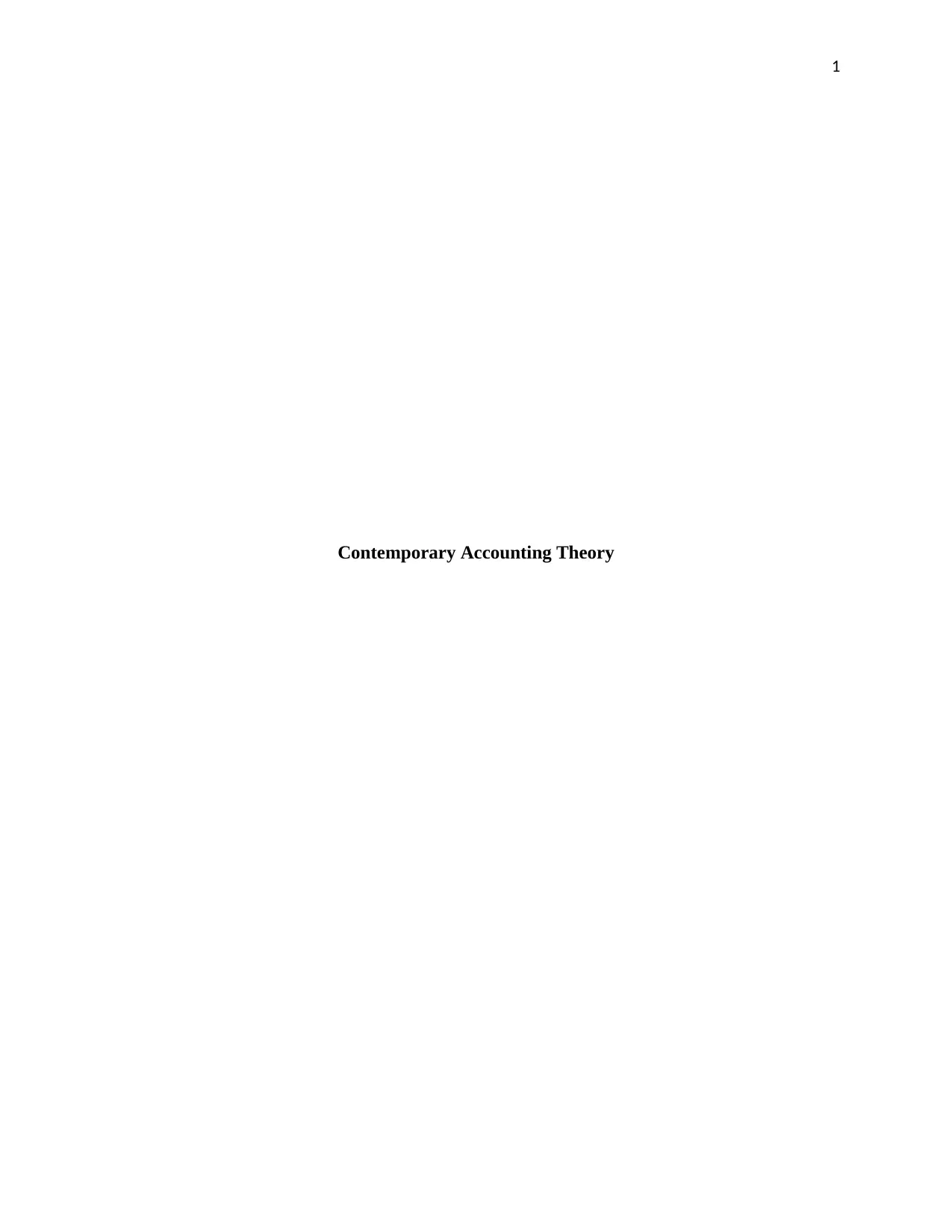
1
Contemporary Accounting Theory
Contemporary Accounting Theory
Paraphrase This Document
Need a fresh take? Get an instant paraphrase of this document with our AI Paraphraser
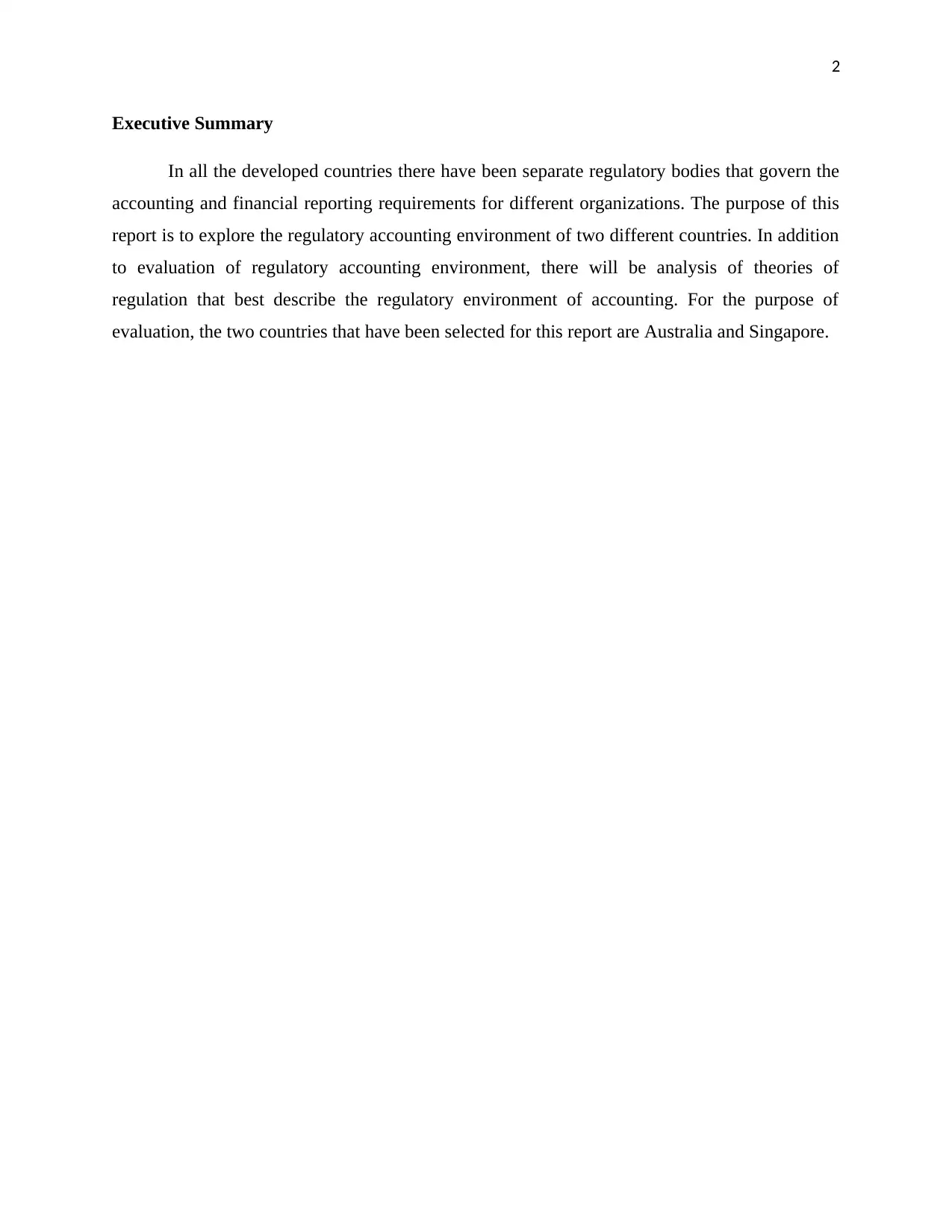
2
Executive Summary
In all the developed countries there have been separate regulatory bodies that govern the
accounting and financial reporting requirements for different organizations. The purpose of this
report is to explore the regulatory accounting environment of two different countries. In addition
to evaluation of regulatory accounting environment, there will be analysis of theories of
regulation that best describe the regulatory environment of accounting. For the purpose of
evaluation, the two countries that have been selected for this report are Australia and Singapore.
Executive Summary
In all the developed countries there have been separate regulatory bodies that govern the
accounting and financial reporting requirements for different organizations. The purpose of this
report is to explore the regulatory accounting environment of two different countries. In addition
to evaluation of regulatory accounting environment, there will be analysis of theories of
regulation that best describe the regulatory environment of accounting. For the purpose of
evaluation, the two countries that have been selected for this report are Australia and Singapore.
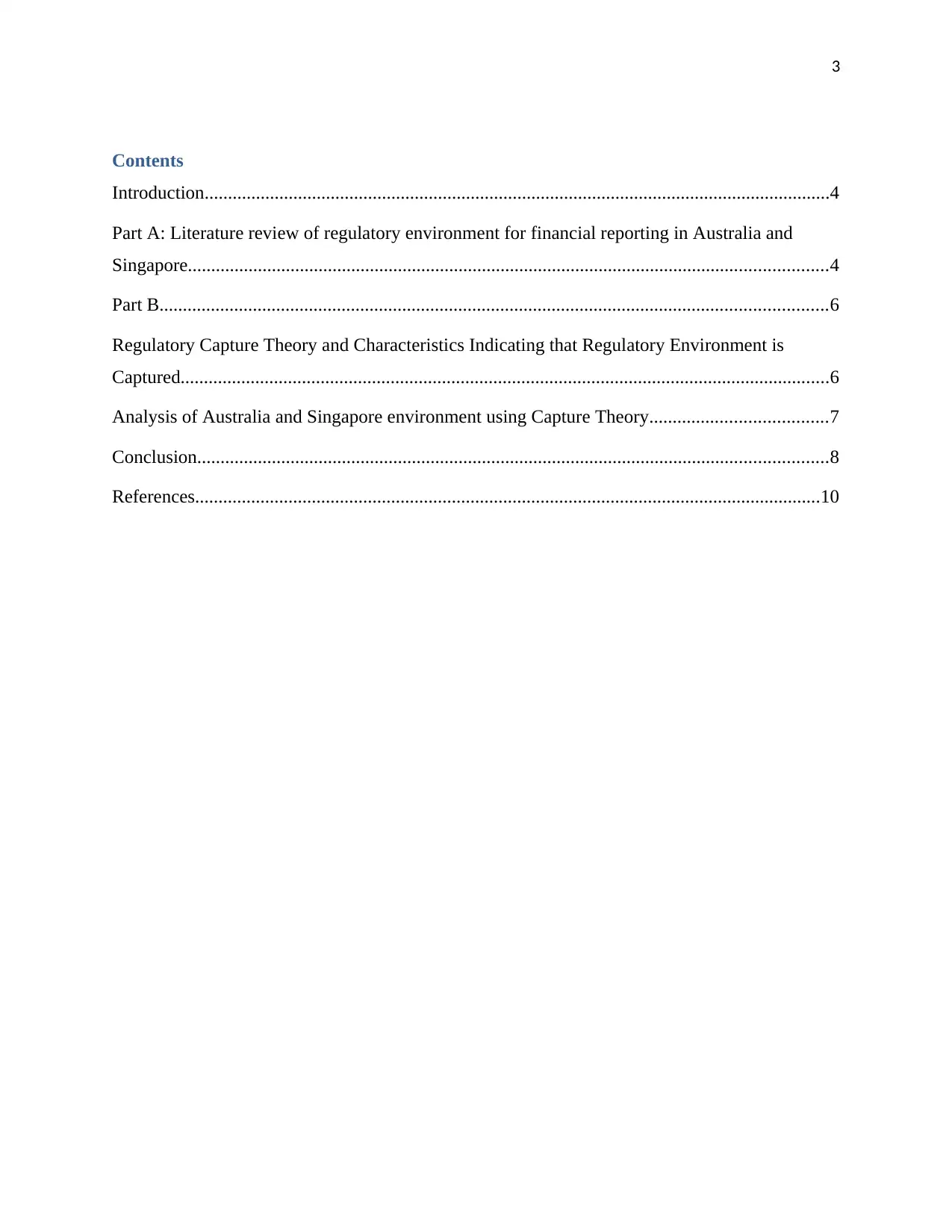
3
Contents
Introduction......................................................................................................................................4
Part A: Literature review of regulatory environment for financial reporting in Australia and
Singapore.........................................................................................................................................4
Part B...............................................................................................................................................6
Regulatory Capture Theory and Characteristics Indicating that Regulatory Environment is
Captured...........................................................................................................................................6
Analysis of Australia and Singapore environment using Capture Theory......................................7
Conclusion.......................................................................................................................................8
References......................................................................................................................................10
Contents
Introduction......................................................................................................................................4
Part A: Literature review of regulatory environment for financial reporting in Australia and
Singapore.........................................................................................................................................4
Part B...............................................................................................................................................6
Regulatory Capture Theory and Characteristics Indicating that Regulatory Environment is
Captured...........................................................................................................................................6
Analysis of Australia and Singapore environment using Capture Theory......................................7
Conclusion.......................................................................................................................................8
References......................................................................................................................................10
⊘ This is a preview!⊘
Do you want full access?
Subscribe today to unlock all pages.

Trusted by 1+ million students worldwide
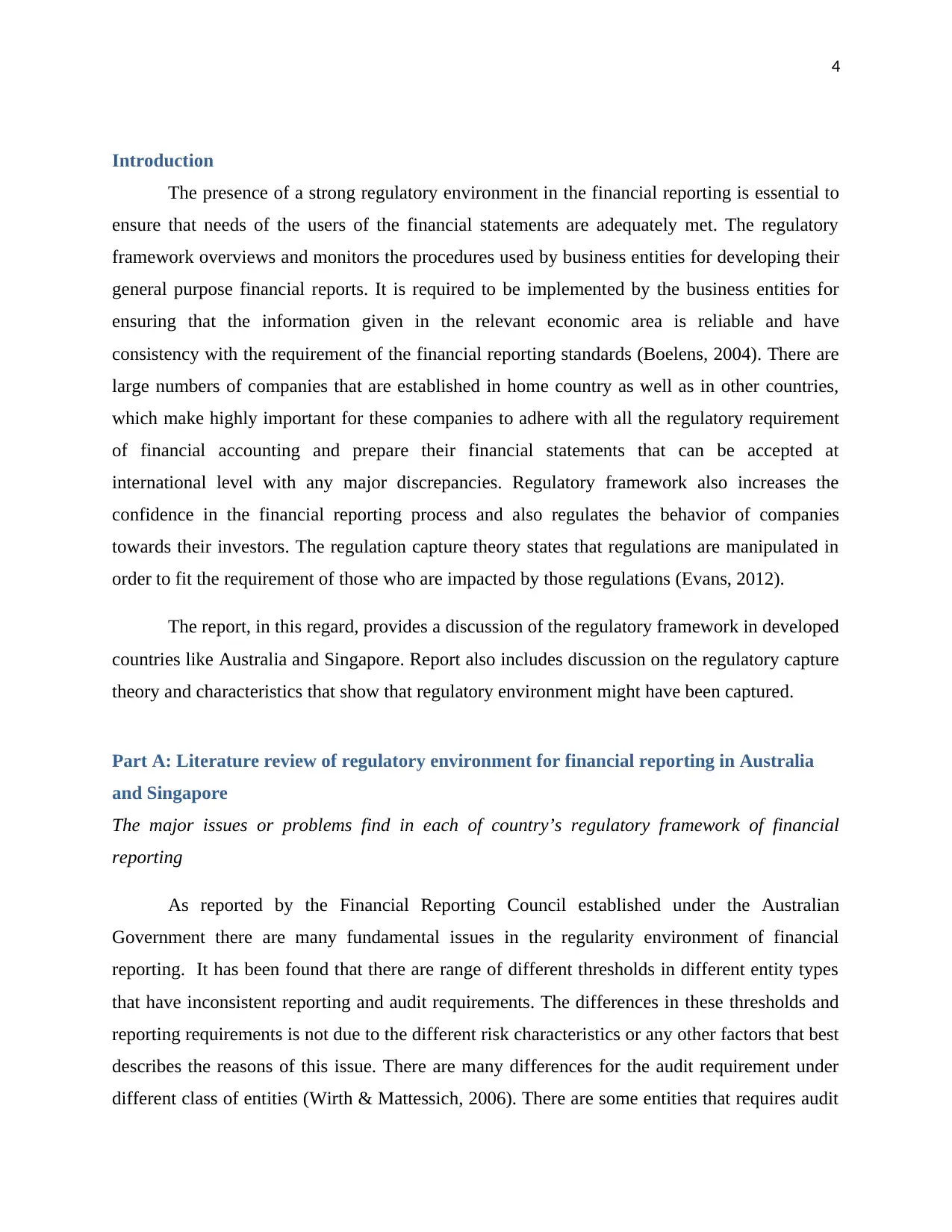
4
Introduction
The presence of a strong regulatory environment in the financial reporting is essential to
ensure that needs of the users of the financial statements are adequately met. The regulatory
framework overviews and monitors the procedures used by business entities for developing their
general purpose financial reports. It is required to be implemented by the business entities for
ensuring that the information given in the relevant economic area is reliable and have
consistency with the requirement of the financial reporting standards (Boelens, 2004). There are
large numbers of companies that are established in home country as well as in other countries,
which make highly important for these companies to adhere with all the regulatory requirement
of financial accounting and prepare their financial statements that can be accepted at
international level with any major discrepancies. Regulatory framework also increases the
confidence in the financial reporting process and also regulates the behavior of companies
towards their investors. The regulation capture theory states that regulations are manipulated in
order to fit the requirement of those who are impacted by those regulations (Evans, 2012).
The report, in this regard, provides a discussion of the regulatory framework in developed
countries like Australia and Singapore. Report also includes discussion on the regulatory capture
theory and characteristics that show that regulatory environment might have been captured.
Part A: Literature review of regulatory environment for financial reporting in Australia
and Singapore
The major issues or problems find in each of country’s regulatory framework of financial
reporting
As reported by the Financial Reporting Council established under the Australian
Government there are many fundamental issues in the regularity environment of financial
reporting. It has been found that there are range of different thresholds in different entity types
that have inconsistent reporting and audit requirements. The differences in these thresholds and
reporting requirements is not due to the different risk characteristics or any other factors that best
describes the reasons of this issue. There are many differences for the audit requirement under
different class of entities (Wirth & Mattessich, 2006). There are some entities that requires audit
Introduction
The presence of a strong regulatory environment in the financial reporting is essential to
ensure that needs of the users of the financial statements are adequately met. The regulatory
framework overviews and monitors the procedures used by business entities for developing their
general purpose financial reports. It is required to be implemented by the business entities for
ensuring that the information given in the relevant economic area is reliable and have
consistency with the requirement of the financial reporting standards (Boelens, 2004). There are
large numbers of companies that are established in home country as well as in other countries,
which make highly important for these companies to adhere with all the regulatory requirement
of financial accounting and prepare their financial statements that can be accepted at
international level with any major discrepancies. Regulatory framework also increases the
confidence in the financial reporting process and also regulates the behavior of companies
towards their investors. The regulation capture theory states that regulations are manipulated in
order to fit the requirement of those who are impacted by those regulations (Evans, 2012).
The report, in this regard, provides a discussion of the regulatory framework in developed
countries like Australia and Singapore. Report also includes discussion on the regulatory capture
theory and characteristics that show that regulatory environment might have been captured.
Part A: Literature review of regulatory environment for financial reporting in Australia
and Singapore
The major issues or problems find in each of country’s regulatory framework of financial
reporting
As reported by the Financial Reporting Council established under the Australian
Government there are many fundamental issues in the regularity environment of financial
reporting. It has been found that there are range of different thresholds in different entity types
that have inconsistent reporting and audit requirements. The differences in these thresholds and
reporting requirements is not due to the different risk characteristics or any other factors that best
describes the reasons of this issue. There are many differences for the audit requirement under
different class of entities (Wirth & Mattessich, 2006). There are some entities that requires audit
Paraphrase This Document
Need a fresh take? Get an instant paraphrase of this document with our AI Paraphraser
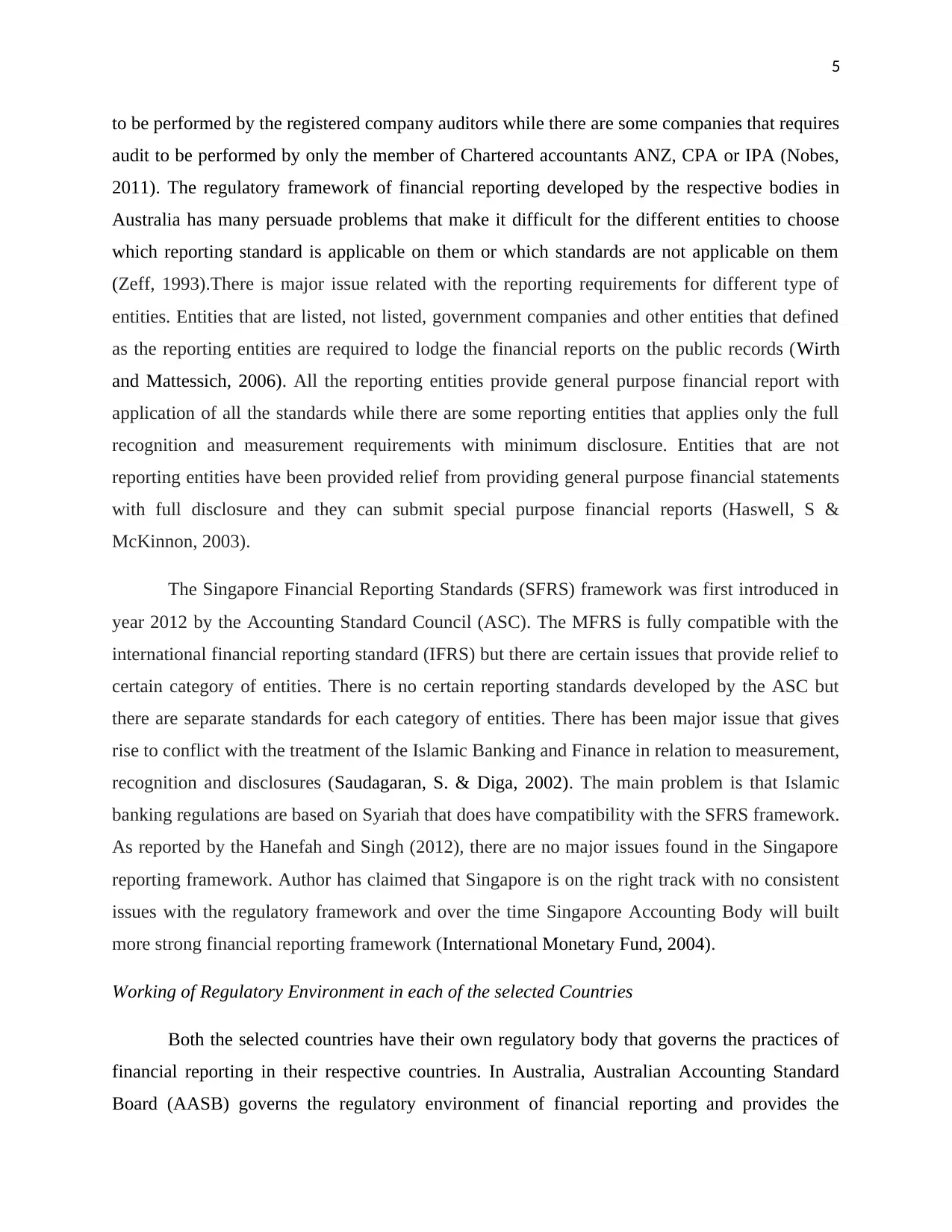
5
to be performed by the registered company auditors while there are some companies that requires
audit to be performed by only the member of Chartered accountants ANZ, CPA or IPA (Nobes,
2011). The regulatory framework of financial reporting developed by the respective bodies in
Australia has many persuade problems that make it difficult for the different entities to choose
which reporting standard is applicable on them or which standards are not applicable on them
(Zeff, 1993).There is major issue related with the reporting requirements for different type of
entities. Entities that are listed, not listed, government companies and other entities that defined
as the reporting entities are required to lodge the financial reports on the public records (Wirth
and Mattessich, 2006). All the reporting entities provide general purpose financial report with
application of all the standards while there are some reporting entities that applies only the full
recognition and measurement requirements with minimum disclosure. Entities that are not
reporting entities have been provided relief from providing general purpose financial statements
with full disclosure and they can submit special purpose financial reports (Haswell, S &
McKinnon, 2003).
The Singapore Financial Reporting Standards (SFRS) framework was first introduced in
year 2012 by the Accounting Standard Council (ASC). The MFRS is fully compatible with the
international financial reporting standard (IFRS) but there are certain issues that provide relief to
certain category of entities. There is no certain reporting standards developed by the ASC but
there are separate standards for each category of entities. There has been major issue that gives
rise to conflict with the treatment of the Islamic Banking and Finance in relation to measurement,
recognition and disclosures (Saudagaran, S. & Diga, 2002). The main problem is that Islamic
banking regulations are based on Syariah that does have compatibility with the SFRS framework.
As reported by the Hanefah and Singh (2012), there are no major issues found in the Singapore
reporting framework. Author has claimed that Singapore is on the right track with no consistent
issues with the regulatory framework and over the time Singapore Accounting Body will built
more strong financial reporting framework (International Monetary Fund, 2004).
Working of Regulatory Environment in each of the selected Countries
Both the selected countries have their own regulatory body that governs the practices of
financial reporting in their respective countries. In Australia, Australian Accounting Standard
Board (AASB) governs the regulatory environment of financial reporting and provides the
to be performed by the registered company auditors while there are some companies that requires
audit to be performed by only the member of Chartered accountants ANZ, CPA or IPA (Nobes,
2011). The regulatory framework of financial reporting developed by the respective bodies in
Australia has many persuade problems that make it difficult for the different entities to choose
which reporting standard is applicable on them or which standards are not applicable on them
(Zeff, 1993).There is major issue related with the reporting requirements for different type of
entities. Entities that are listed, not listed, government companies and other entities that defined
as the reporting entities are required to lodge the financial reports on the public records (Wirth
and Mattessich, 2006). All the reporting entities provide general purpose financial report with
application of all the standards while there are some reporting entities that applies only the full
recognition and measurement requirements with minimum disclosure. Entities that are not
reporting entities have been provided relief from providing general purpose financial statements
with full disclosure and they can submit special purpose financial reports (Haswell, S &
McKinnon, 2003).
The Singapore Financial Reporting Standards (SFRS) framework was first introduced in
year 2012 by the Accounting Standard Council (ASC). The MFRS is fully compatible with the
international financial reporting standard (IFRS) but there are certain issues that provide relief to
certain category of entities. There is no certain reporting standards developed by the ASC but
there are separate standards for each category of entities. There has been major issue that gives
rise to conflict with the treatment of the Islamic Banking and Finance in relation to measurement,
recognition and disclosures (Saudagaran, S. & Diga, 2002). The main problem is that Islamic
banking regulations are based on Syariah that does have compatibility with the SFRS framework.
As reported by the Hanefah and Singh (2012), there are no major issues found in the Singapore
reporting framework. Author has claimed that Singapore is on the right track with no consistent
issues with the regulatory framework and over the time Singapore Accounting Body will built
more strong financial reporting framework (International Monetary Fund, 2004).
Working of Regulatory Environment in each of the selected Countries
Both the selected countries have their own regulatory body that governs the practices of
financial reporting in their respective countries. In Australia, Australian Accounting Standard
Board (AASB) governs the regulatory environment of financial reporting and provides the
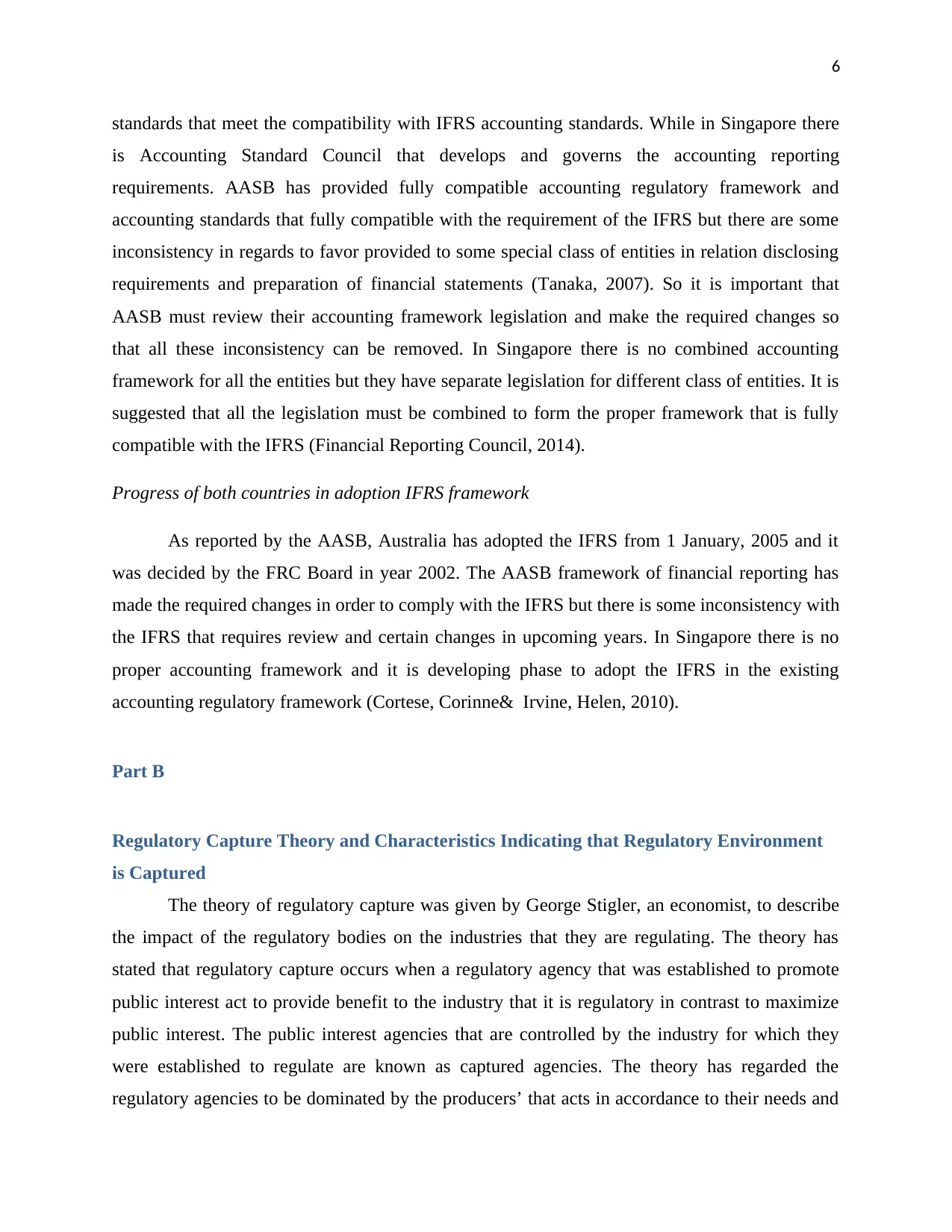
6
standards that meet the compatibility with IFRS accounting standards. While in Singapore there
is Accounting Standard Council that develops and governs the accounting reporting
requirements. AASB has provided fully compatible accounting regulatory framework and
accounting standards that fully compatible with the requirement of the IFRS but there are some
inconsistency in regards to favor provided to some special class of entities in relation disclosing
requirements and preparation of financial statements (Tanaka, 2007). So it is important that
AASB must review their accounting framework legislation and make the required changes so
that all these inconsistency can be removed. In Singapore there is no combined accounting
framework for all the entities but they have separate legislation for different class of entities. It is
suggested that all the legislation must be combined to form the proper framework that is fully
compatible with the IFRS (Financial Reporting Council, 2014).
Progress of both countries in adoption IFRS framework
As reported by the AASB, Australia has adopted the IFRS from 1 January, 2005 and it
was decided by the FRC Board in year 2002. The AASB framework of financial reporting has
made the required changes in order to comply with the IFRS but there is some inconsistency with
the IFRS that requires review and certain changes in upcoming years. In Singapore there is no
proper accounting framework and it is developing phase to adopt the IFRS in the existing
accounting regulatory framework (Cortese, Corinne& Irvine, Helen, 2010).
Part B
Regulatory Capture Theory and Characteristics Indicating that Regulatory Environment
is Captured
The theory of regulatory capture was given by George Stigler, an economist, to describe
the impact of the regulatory bodies on the industries that they are regulating. The theory has
stated that regulatory capture occurs when a regulatory agency that was established to promote
public interest act to provide benefit to the industry that it is regulatory in contrast to maximize
public interest. The public interest agencies that are controlled by the industry for which they
were established to regulate are known as captured agencies. The theory has regarded the
regulatory agencies to be dominated by the producers’ that acts in accordance to their needs and
standards that meet the compatibility with IFRS accounting standards. While in Singapore there
is Accounting Standard Council that develops and governs the accounting reporting
requirements. AASB has provided fully compatible accounting regulatory framework and
accounting standards that fully compatible with the requirement of the IFRS but there are some
inconsistency in regards to favor provided to some special class of entities in relation disclosing
requirements and preparation of financial statements (Tanaka, 2007). So it is important that
AASB must review their accounting framework legislation and make the required changes so
that all these inconsistency can be removed. In Singapore there is no combined accounting
framework for all the entities but they have separate legislation for different class of entities. It is
suggested that all the legislation must be combined to form the proper framework that is fully
compatible with the IFRS (Financial Reporting Council, 2014).
Progress of both countries in adoption IFRS framework
As reported by the AASB, Australia has adopted the IFRS from 1 January, 2005 and it
was decided by the FRC Board in year 2002. The AASB framework of financial reporting has
made the required changes in order to comply with the IFRS but there is some inconsistency with
the IFRS that requires review and certain changes in upcoming years. In Singapore there is no
proper accounting framework and it is developing phase to adopt the IFRS in the existing
accounting regulatory framework (Cortese, Corinne& Irvine, Helen, 2010).
Part B
Regulatory Capture Theory and Characteristics Indicating that Regulatory Environment
is Captured
The theory of regulatory capture was given by George Stigler, an economist, to describe
the impact of the regulatory bodies on the industries that they are regulating. The theory has
stated that regulatory capture occurs when a regulatory agency that was established to promote
public interest act to provide benefit to the industry that it is regulatory in contrast to maximize
public interest. The public interest agencies that are controlled by the industry for which they
were established to regulate are known as captured agencies. The theory has regarded the
regulatory agencies to be dominated by the producers’ that acts in accordance to their needs and
⊘ This is a preview!⊘
Do you want full access?
Subscribe today to unlock all pages.

Trusted by 1+ million students worldwide
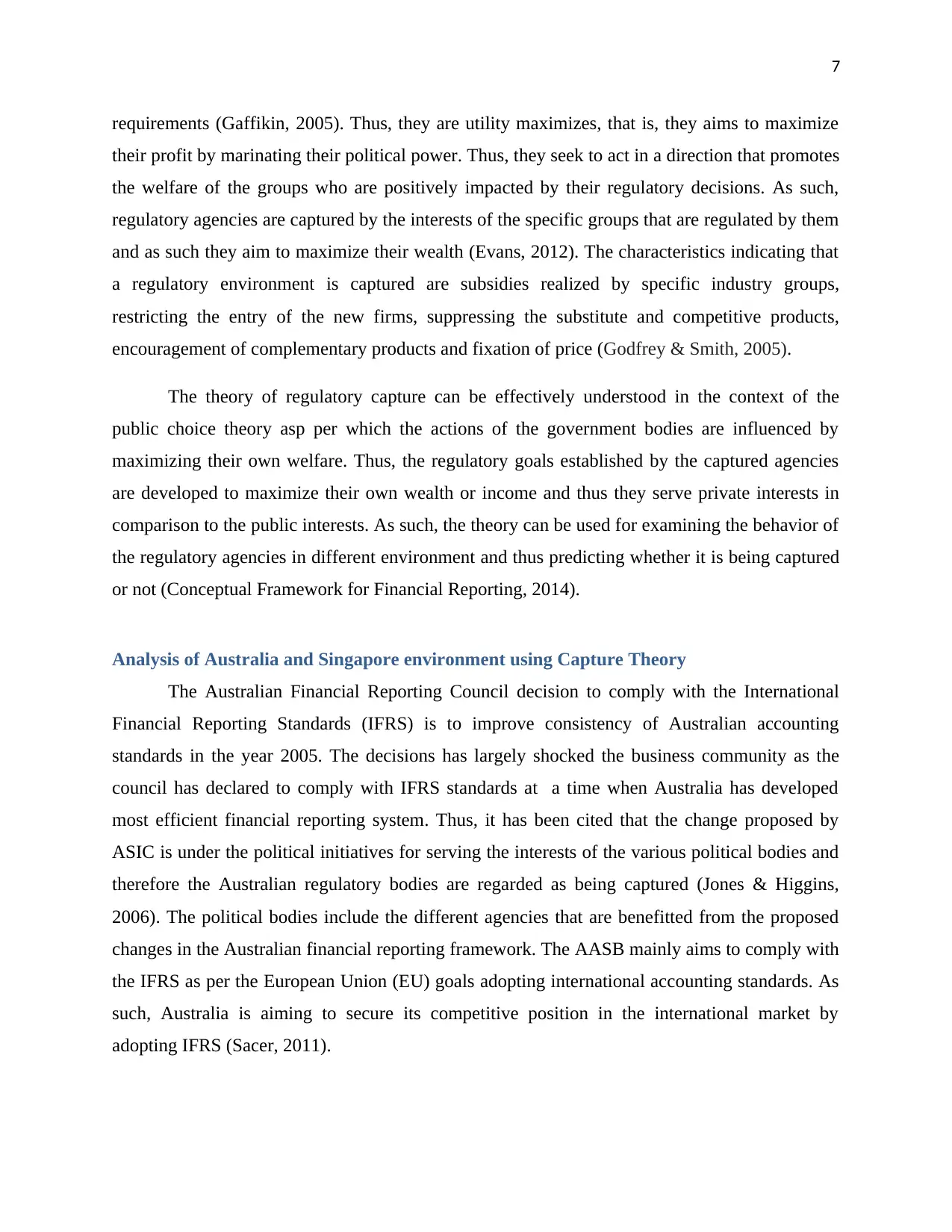
7
requirements (Gaffikin, 2005). Thus, they are utility maximizes, that is, they aims to maximize
their profit by marinating their political power. Thus, they seek to act in a direction that promotes
the welfare of the groups who are positively impacted by their regulatory decisions. As such,
regulatory agencies are captured by the interests of the specific groups that are regulated by them
and as such they aim to maximize their wealth (Evans, 2012). The characteristics indicating that
a regulatory environment is captured are subsidies realized by specific industry groups,
restricting the entry of the new firms, suppressing the substitute and competitive products,
encouragement of complementary products and fixation of price (Godfrey & Smith, 2005).
The theory of regulatory capture can be effectively understood in the context of the
public choice theory asp per which the actions of the government bodies are influenced by
maximizing their own welfare. Thus, the regulatory goals established by the captured agencies
are developed to maximize their own wealth or income and thus they serve private interests in
comparison to the public interests. As such, the theory can be used for examining the behavior of
the regulatory agencies in different environment and thus predicting whether it is being captured
or not (Conceptual Framework for Financial Reporting, 2014).
Analysis of Australia and Singapore environment using Capture Theory
The Australian Financial Reporting Council decision to comply with the International
Financial Reporting Standards (IFRS) is to improve consistency of Australian accounting
standards in the year 2005. The decisions has largely shocked the business community as the
council has declared to comply with IFRS standards at a time when Australia has developed
most efficient financial reporting system. Thus, it has been cited that the change proposed by
ASIC is under the political initiatives for serving the interests of the various political bodies and
therefore the Australian regulatory bodies are regarded as being captured (Jones & Higgins,
2006). The political bodies include the different agencies that are benefitted from the proposed
changes in the Australian financial reporting framework. The AASB mainly aims to comply with
the IFRS as per the European Union (EU) goals adopting international accounting standards. As
such, Australia is aiming to secure its competitive position in the international market by
adopting IFRS (Sacer, 2011).
requirements (Gaffikin, 2005). Thus, they are utility maximizes, that is, they aims to maximize
their profit by marinating their political power. Thus, they seek to act in a direction that promotes
the welfare of the groups who are positively impacted by their regulatory decisions. As such,
regulatory agencies are captured by the interests of the specific groups that are regulated by them
and as such they aim to maximize their wealth (Evans, 2012). The characteristics indicating that
a regulatory environment is captured are subsidies realized by specific industry groups,
restricting the entry of the new firms, suppressing the substitute and competitive products,
encouragement of complementary products and fixation of price (Godfrey & Smith, 2005).
The theory of regulatory capture can be effectively understood in the context of the
public choice theory asp per which the actions of the government bodies are influenced by
maximizing their own welfare. Thus, the regulatory goals established by the captured agencies
are developed to maximize their own wealth or income and thus they serve private interests in
comparison to the public interests. As such, the theory can be used for examining the behavior of
the regulatory agencies in different environment and thus predicting whether it is being captured
or not (Conceptual Framework for Financial Reporting, 2014).
Analysis of Australia and Singapore environment using Capture Theory
The Australian Financial Reporting Council decision to comply with the International
Financial Reporting Standards (IFRS) is to improve consistency of Australian accounting
standards in the year 2005. The decisions has largely shocked the business community as the
council has declared to comply with IFRS standards at a time when Australia has developed
most efficient financial reporting system. Thus, it has been cited that the change proposed by
ASIC is under the political initiatives for serving the interests of the various political bodies and
therefore the Australian regulatory bodies are regarded as being captured (Jones & Higgins,
2006). The political bodies include the different agencies that are benefitted from the proposed
changes in the Australian financial reporting framework. The AASB mainly aims to comply with
the IFRS as per the European Union (EU) goals adopting international accounting standards. As
such, Australia is aiming to secure its competitive position in the international market by
adopting IFRS (Sacer, 2011).
Paraphrase This Document
Need a fresh take? Get an instant paraphrase of this document with our AI Paraphraser
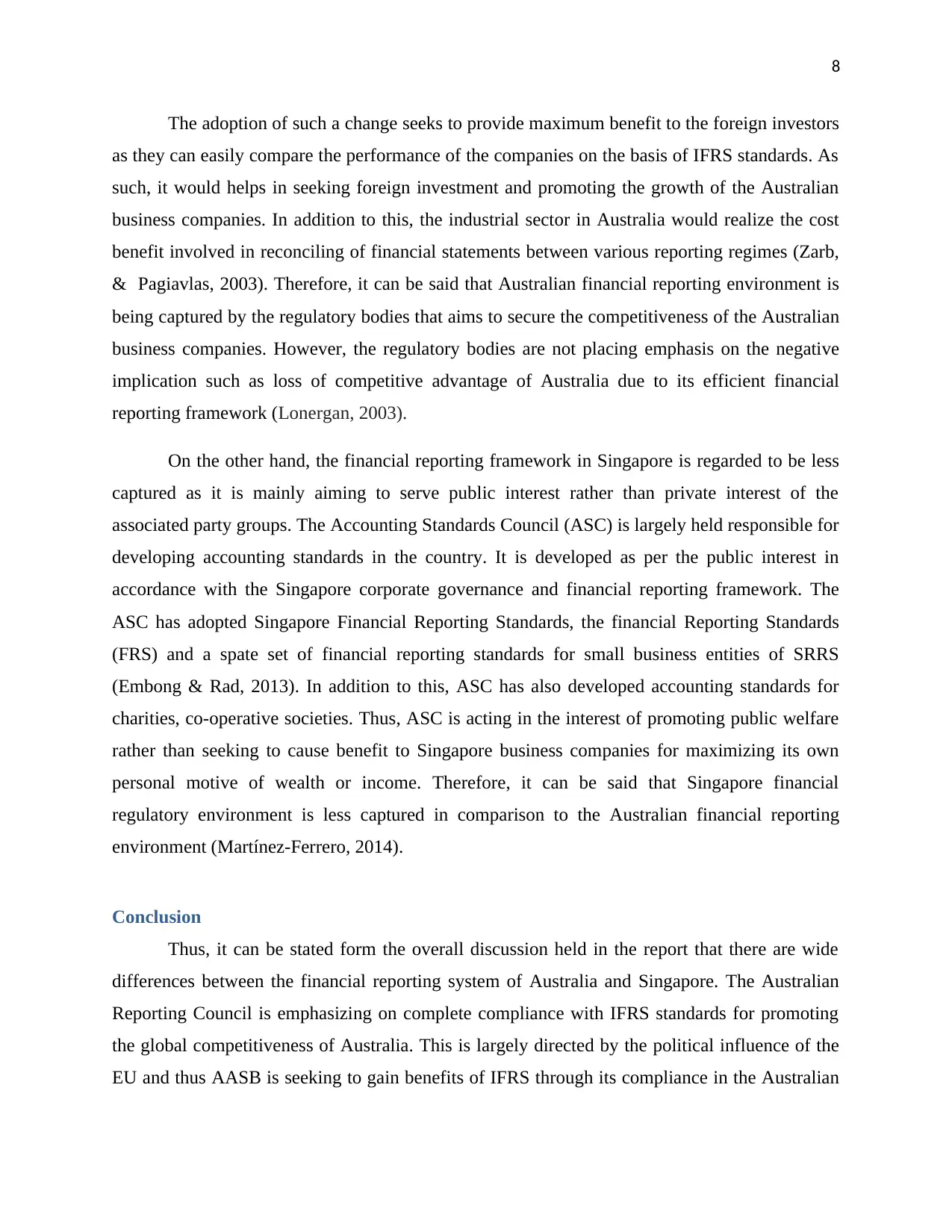
8
The adoption of such a change seeks to provide maximum benefit to the foreign investors
as they can easily compare the performance of the companies on the basis of IFRS standards. As
such, it would helps in seeking foreign investment and promoting the growth of the Australian
business companies. In addition to this, the industrial sector in Australia would realize the cost
benefit involved in reconciling of financial statements between various reporting regimes (Zarb,
& Pagiavlas, 2003). Therefore, it can be said that Australian financial reporting environment is
being captured by the regulatory bodies that aims to secure the competitiveness of the Australian
business companies. However, the regulatory bodies are not placing emphasis on the negative
implication such as loss of competitive advantage of Australia due to its efficient financial
reporting framework (Lonergan, 2003).
On the other hand, the financial reporting framework in Singapore is regarded to be less
captured as it is mainly aiming to serve public interest rather than private interest of the
associated party groups. The Accounting Standards Council (ASC) is largely held responsible for
developing accounting standards in the country. It is developed as per the public interest in
accordance with the Singapore corporate governance and financial reporting framework. The
ASC has adopted Singapore Financial Reporting Standards, the financial Reporting Standards
(FRS) and a spate set of financial reporting standards for small business entities of SRRS
(Embong & Rad, 2013). In addition to this, ASC has also developed accounting standards for
charities, co-operative societies. Thus, ASC is acting in the interest of promoting public welfare
rather than seeking to cause benefit to Singapore business companies for maximizing its own
personal motive of wealth or income. Therefore, it can be said that Singapore financial
regulatory environment is less captured in comparison to the Australian financial reporting
environment (Martínez-Ferrero, 2014).
Conclusion
Thus, it can be stated form the overall discussion held in the report that there are wide
differences between the financial reporting system of Australia and Singapore. The Australian
Reporting Council is emphasizing on complete compliance with IFRS standards for promoting
the global competitiveness of Australia. This is largely directed by the political influence of the
EU and thus AASB is seeking to gain benefits of IFRS through its compliance in the Australian
The adoption of such a change seeks to provide maximum benefit to the foreign investors
as they can easily compare the performance of the companies on the basis of IFRS standards. As
such, it would helps in seeking foreign investment and promoting the growth of the Australian
business companies. In addition to this, the industrial sector in Australia would realize the cost
benefit involved in reconciling of financial statements between various reporting regimes (Zarb,
& Pagiavlas, 2003). Therefore, it can be said that Australian financial reporting environment is
being captured by the regulatory bodies that aims to secure the competitiveness of the Australian
business companies. However, the regulatory bodies are not placing emphasis on the negative
implication such as loss of competitive advantage of Australia due to its efficient financial
reporting framework (Lonergan, 2003).
On the other hand, the financial reporting framework in Singapore is regarded to be less
captured as it is mainly aiming to serve public interest rather than private interest of the
associated party groups. The Accounting Standards Council (ASC) is largely held responsible for
developing accounting standards in the country. It is developed as per the public interest in
accordance with the Singapore corporate governance and financial reporting framework. The
ASC has adopted Singapore Financial Reporting Standards, the financial Reporting Standards
(FRS) and a spate set of financial reporting standards for small business entities of SRRS
(Embong & Rad, 2013). In addition to this, ASC has also developed accounting standards for
charities, co-operative societies. Thus, ASC is acting in the interest of promoting public welfare
rather than seeking to cause benefit to Singapore business companies for maximizing its own
personal motive of wealth or income. Therefore, it can be said that Singapore financial
regulatory environment is less captured in comparison to the Australian financial reporting
environment (Martínez-Ferrero, 2014).
Conclusion
Thus, it can be stated form the overall discussion held in the report that there are wide
differences between the financial reporting system of Australia and Singapore. The Australian
Reporting Council is emphasizing on complete compliance with IFRS standards for promoting
the global competitiveness of Australia. This is largely directed by the political influence of the
EU and thus AASB is seeking to gain benefits of IFRS through its compliance in the Australian
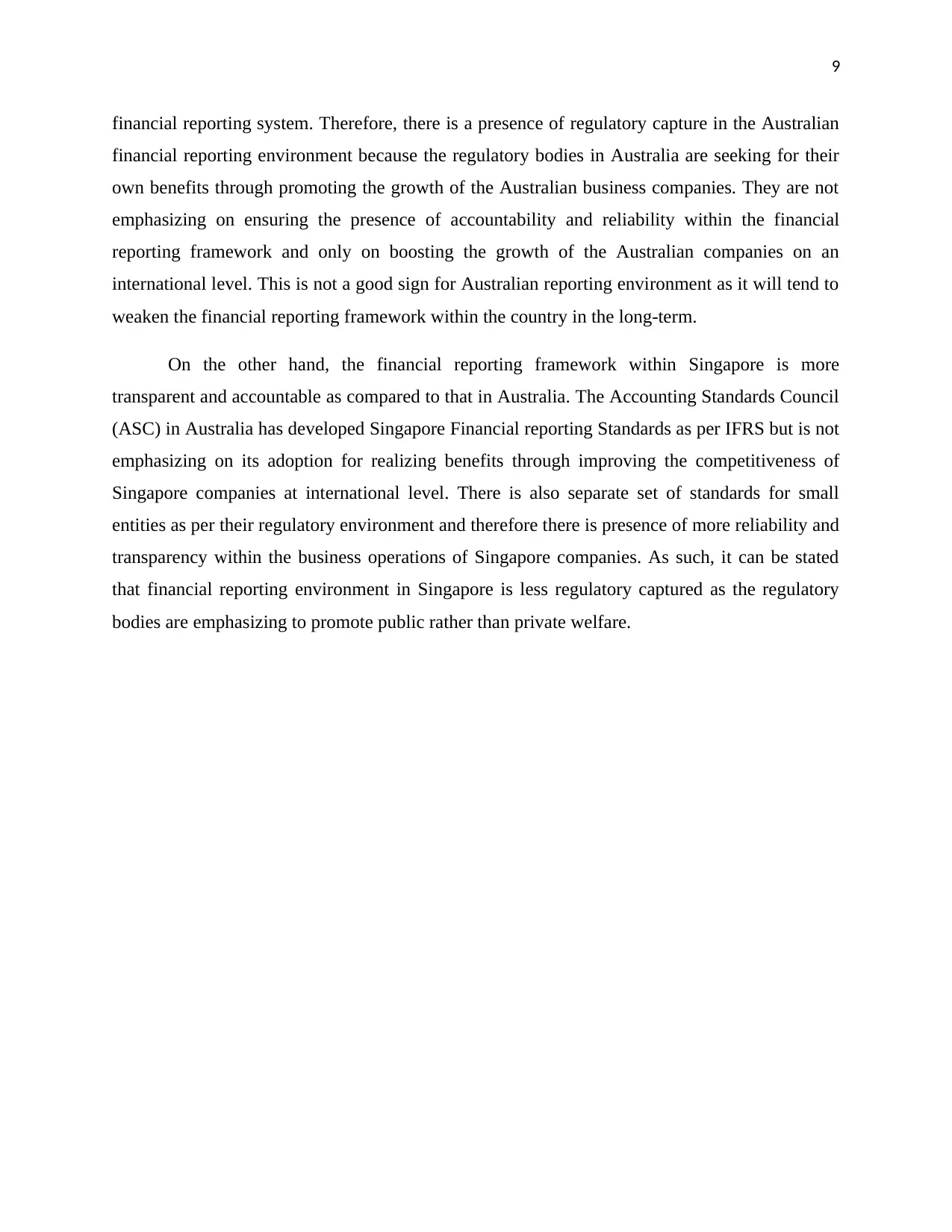
9
financial reporting system. Therefore, there is a presence of regulatory capture in the Australian
financial reporting environment because the regulatory bodies in Australia are seeking for their
own benefits through promoting the growth of the Australian business companies. They are not
emphasizing on ensuring the presence of accountability and reliability within the financial
reporting framework and only on boosting the growth of the Australian companies on an
international level. This is not a good sign for Australian reporting environment as it will tend to
weaken the financial reporting framework within the country in the long-term.
On the other hand, the financial reporting framework within Singapore is more
transparent and accountable as compared to that in Australia. The Accounting Standards Council
(ASC) in Australia has developed Singapore Financial reporting Standards as per IFRS but is not
emphasizing on its adoption for realizing benefits through improving the competitiveness of
Singapore companies at international level. There is also separate set of standards for small
entities as per their regulatory environment and therefore there is presence of more reliability and
transparency within the business operations of Singapore companies. As such, it can be stated
that financial reporting environment in Singapore is less regulatory captured as the regulatory
bodies are emphasizing to promote public rather than private welfare.
financial reporting system. Therefore, there is a presence of regulatory capture in the Australian
financial reporting environment because the regulatory bodies in Australia are seeking for their
own benefits through promoting the growth of the Australian business companies. They are not
emphasizing on ensuring the presence of accountability and reliability within the financial
reporting framework and only on boosting the growth of the Australian companies on an
international level. This is not a good sign for Australian reporting environment as it will tend to
weaken the financial reporting framework within the country in the long-term.
On the other hand, the financial reporting framework within Singapore is more
transparent and accountable as compared to that in Australia. The Accounting Standards Council
(ASC) in Australia has developed Singapore Financial reporting Standards as per IFRS but is not
emphasizing on its adoption for realizing benefits through improving the competitiveness of
Singapore companies at international level. There is also separate set of standards for small
entities as per their regulatory environment and therefore there is presence of more reliability and
transparency within the business operations of Singapore companies. As such, it can be stated
that financial reporting environment in Singapore is less regulatory captured as the regulatory
bodies are emphasizing to promote public rather than private welfare.
⊘ This is a preview!⊘
Do you want full access?
Subscribe today to unlock all pages.

Trusted by 1+ million students worldwide
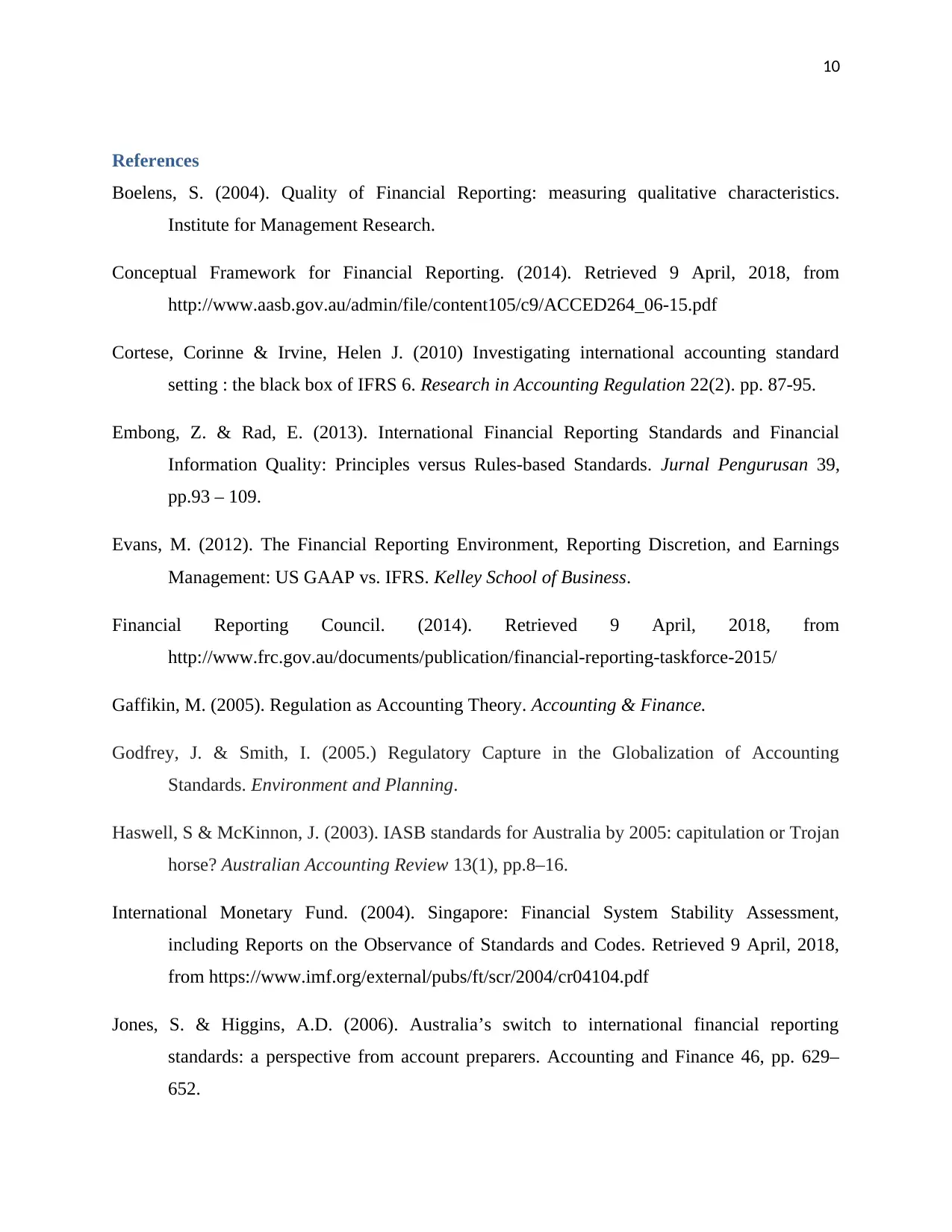
10
References
Boelens, S. (2004). Quality of Financial Reporting: measuring qualitative characteristics.
Institute for Management Research.
Conceptual Framework for Financial Reporting. (2014). Retrieved 9 April, 2018, from
http://www.aasb.gov.au/admin/file/content105/c9/ACCED264_06-15.pdf
Cortese, Corinne & Irvine, Helen J. (2010) Investigating international accounting standard
setting : the black box of IFRS 6. Research in Accounting Regulation 22(2). pp. 87-95.
Embong, Z. & Rad, E. (2013). International Financial Reporting Standards and Financial
Information Quality: Principles versus Rules-based Standards. Jurnal Pengurusan 39,
pp.93 – 109.
Evans, M. (2012). The Financial Reporting Environment, Reporting Discretion, and Earnings
Management: US GAAP vs. IFRS. Kelley School of Business.
Financial Reporting Council. (2014). Retrieved 9 April, 2018, from
http://www.frc.gov.au/documents/publication/financial-reporting-taskforce-2015/
Gaffikin, M. (2005). Regulation as Accounting Theory. Accounting & Finance.
Godfrey, J. & Smith, I. (2005.) Regulatory Capture in the Globalization of Accounting
Standards. Environment and Planning.
Haswell, S & McKinnon, J. (2003). IASB standards for Australia by 2005: capitulation or Trojan
horse? Australian Accounting Review 13(1), pp.8–16.
International Monetary Fund. (2004). Singapore: Financial System Stability Assessment,
including Reports on the Observance of Standards and Codes. Retrieved 9 April, 2018,
from https://www.imf.org/external/pubs/ft/scr/2004/cr04104.pdf
Jones, S. & Higgins, A.D. (2006). Australia’s switch to international financial reporting
standards: a perspective from account preparers. Accounting and Finance 46, pp. 629–
652.
References
Boelens, S. (2004). Quality of Financial Reporting: measuring qualitative characteristics.
Institute for Management Research.
Conceptual Framework for Financial Reporting. (2014). Retrieved 9 April, 2018, from
http://www.aasb.gov.au/admin/file/content105/c9/ACCED264_06-15.pdf
Cortese, Corinne & Irvine, Helen J. (2010) Investigating international accounting standard
setting : the black box of IFRS 6. Research in Accounting Regulation 22(2). pp. 87-95.
Embong, Z. & Rad, E. (2013). International Financial Reporting Standards and Financial
Information Quality: Principles versus Rules-based Standards. Jurnal Pengurusan 39,
pp.93 – 109.
Evans, M. (2012). The Financial Reporting Environment, Reporting Discretion, and Earnings
Management: US GAAP vs. IFRS. Kelley School of Business.
Financial Reporting Council. (2014). Retrieved 9 April, 2018, from
http://www.frc.gov.au/documents/publication/financial-reporting-taskforce-2015/
Gaffikin, M. (2005). Regulation as Accounting Theory. Accounting & Finance.
Godfrey, J. & Smith, I. (2005.) Regulatory Capture in the Globalization of Accounting
Standards. Environment and Planning.
Haswell, S & McKinnon, J. (2003). IASB standards for Australia by 2005: capitulation or Trojan
horse? Australian Accounting Review 13(1), pp.8–16.
International Monetary Fund. (2004). Singapore: Financial System Stability Assessment,
including Reports on the Observance of Standards and Codes. Retrieved 9 April, 2018,
from https://www.imf.org/external/pubs/ft/scr/2004/cr04104.pdf
Jones, S. & Higgins, A.D. (2006). Australia’s switch to international financial reporting
standards: a perspective from account preparers. Accounting and Finance 46, pp. 629–
652.
Paraphrase This Document
Need a fresh take? Get an instant paraphrase of this document with our AI Paraphraser
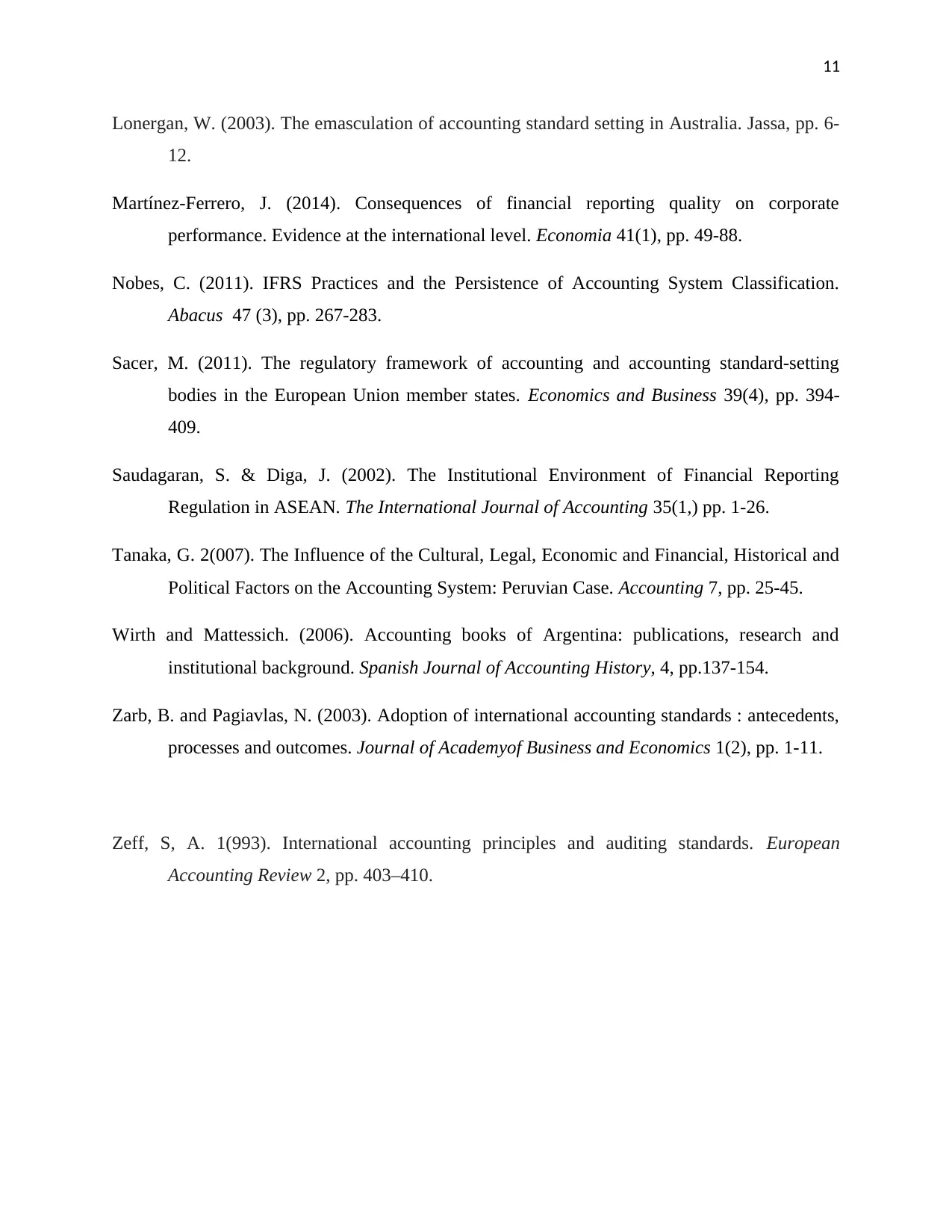
11
Lonergan, W. (2003). The emasculation of accounting standard setting in Australia. Jassa, pp. 6-
12.
Martínez-Ferrero, J. (2014). Consequences of financial reporting quality on corporate
performance. Evidence at the international level. Economia 41(1), pp. 49-88.
Nobes, C. (2011). IFRS Practices and the Persistence of Accounting System Classification.
Abacus 47 (3), pp. 267-283.
Sacer, M. (2011). The regulatory framework of accounting and accounting standard-setting
bodies in the European Union member states. Economics and Business 39(4), pp. 394-
409.
Saudagaran, S. & Diga, J. (2002). The Institutional Environment of Financial Reporting
Regulation in ASEAN. The International Journal of Accounting 35(1,) pp. 1-26.
Tanaka, G. 2(007). The Influence of the Cultural, Legal, Economic and Financial, Historical and
Political Factors on the Accounting System: Peruvian Case. Accounting 7, pp. 25-45.
Wirth and Mattessich. (2006). Accounting books of Argentina: publications, research and
institutional background. Spanish Journal of Accounting History, 4, pp.137-154.
Zarb, B. and Pagiavlas, N. (2003). Adoption of international accounting standards : antecedents,
processes and outcomes. Journal of Academyof Business and Economics 1(2), pp. 1-11.
Zeff, S, A. 1(993). International accounting principles and auditing standards. European
Accounting Review 2, pp. 403–410.
Lonergan, W. (2003). The emasculation of accounting standard setting in Australia. Jassa, pp. 6-
12.
Martínez-Ferrero, J. (2014). Consequences of financial reporting quality on corporate
performance. Evidence at the international level. Economia 41(1), pp. 49-88.
Nobes, C. (2011). IFRS Practices and the Persistence of Accounting System Classification.
Abacus 47 (3), pp. 267-283.
Sacer, M. (2011). The regulatory framework of accounting and accounting standard-setting
bodies in the European Union member states. Economics and Business 39(4), pp. 394-
409.
Saudagaran, S. & Diga, J. (2002). The Institutional Environment of Financial Reporting
Regulation in ASEAN. The International Journal of Accounting 35(1,) pp. 1-26.
Tanaka, G. 2(007). The Influence of the Cultural, Legal, Economic and Financial, Historical and
Political Factors on the Accounting System: Peruvian Case. Accounting 7, pp. 25-45.
Wirth and Mattessich. (2006). Accounting books of Argentina: publications, research and
institutional background. Spanish Journal of Accounting History, 4, pp.137-154.
Zarb, B. and Pagiavlas, N. (2003). Adoption of international accounting standards : antecedents,
processes and outcomes. Journal of Academyof Business and Economics 1(2), pp. 1-11.
Zeff, S, A. 1(993). International accounting principles and auditing standards. European
Accounting Review 2, pp. 403–410.

12
⊘ This is a preview!⊘
Do you want full access?
Subscribe today to unlock all pages.

Trusted by 1+ million students worldwide
1 out of 12
Related Documents
Your All-in-One AI-Powered Toolkit for Academic Success.
+13062052269
info@desklib.com
Available 24*7 on WhatsApp / Email
![[object Object]](/_next/static/media/star-bottom.7253800d.svg)
Unlock your academic potential
Copyright © 2020–2025 A2Z Services. All Rights Reserved. Developed and managed by ZUCOL.



